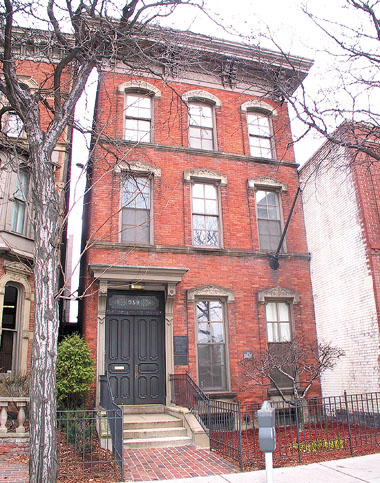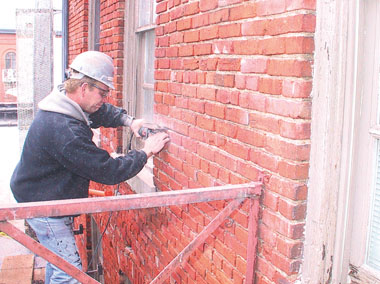Masons to put a handsome new face on old Beaubien House
Date Posted: December 24 2004
With a few nip and tuck points where needed, new mortar, as well as a vigorous cleaning, a facelift on the exterior brick of one of Detroit's oldest homes - the Beaubien House - will soon have it looking as good as it did when it was constructed in 1851.
Davenport Masonry is donating the masonry restoration of the house, which acts as office space for the nonprofit American Institute of Architects-Michigan.
The architects are striving to be good stewards of the Italianate Townhouse-style structure, and Davenport and its Bricklayers and Allied Craftworkers Local 1 craftsman are providing their considerable talent to make the restoration happen.
"This architectural jewel, which is historically and architecturally significant, is important to the economic value of the City of Detroit," said Ed Davenport of Davenport Masonry. "Americans have rediscovered and embraced the historic elements of their cities. A building like this preserves the community's distinctive appearance."
The three-story house was built for a middle-class family on the former Antoine Beaubien farm. Today, the house is located on a narrow plot of ground in a most unlikely spot - across busy Jefferson Avenue from the Renaissance Center.
A history of the house prepared by the Michigan AIA said it "is one of the last remaining residences in what was once the premier residential street in Detroit."
The house was built by a local carpenter for Antoine Beaubien's cousin Charles Trombly and his wife, Elizabeth Knaggs. Over the years it was owned or rented by a number of families. Converted into apartments in approximately 1965, the building was restored in 1977 and eventually became the headquarters for the AIA-Michigan.
(A little further east on Jefferson is the Moross House, which the AIA said is the oldest authenticated house in the city, built sometime between 1843-1848). According to the AIA-Michigan, which has owned the Beaubien house since 1981, about 15 similar homes were built in the area, but were torn down in the 1950s for more parking lots.
"The 1950s must be one of the blackest decades for Detroit's architectural historians," the AIA said. "Hundreds of important buildings were demolished just before public interest and concern were mobilized for their preservation."
The Beaubien House is on the National Register of Historic Places. The scope of Davenport's work includes cleaning, removing and replacing deteriorated brick, then tuck-pointing, cleaning and sealing the surface. Scaffolding for the project was donated by Schuster Construction Services. Work began at the back of the building in early December, and when the weather warms early next year Davenport masons will complete the sides and the front.
The job is led by Davenport Project Manager John Fletcher. Foreman Rick Sudderth along with Jeff Hugill of BAC Local 1 were on the job grinding out loose mortar when we paid a visit earlier this month. Sudderth said Davenport went to the trouble of sending out a sample of the mortar to be tested, so that an exact match could be found.
"Autoclaved" mortar consisting of lime and sharp sand is rarely used on modern buildings, but it will be used between the Beaubien House bricks in this renovation. The autoclaved mortar is different from a modern mortar because of different ingredients and because it has to be given some set-up time after it is mixed and before it is applied. Sudderth said they would be making repairs to brick and mortar that have lasted 150 years - as well as repairing a poorly done renovation job in the 1980s.
The masons said it was a stroke of luck that matching bricks were available at no cost from a building from same era that's undergoing a renovation next door. When work on the Beaubien House is complete, Sudderth estimated that 90 percent of the original 1850s brick would be retained on the fascia, with the remainder modern, matching brick.
"There is some spalling of the old brick, but most of the mortar joints are in remarkably good shape," Sudderth said. "By using the autoclaved mortar, it will help us aesthetically to match the new with the old. It's such a beautiful building with a lot of character."
Rae Dumke, Executive Director of the AIA-Michigan, said the interior of the
building was completely renovated and converted into the present configuration
of office space in 1987.
"It's a great old building, and we're fortunate
and extremely pleased that architects, contractors and building trades have come
together to help us," she said.

THE EXTERIOR BRICK on the Beaubien House - one of Detroit's oldest - is getting refurbished through the efforts of Davenport Masonry and BAC Local 1 masons.

GRINDING OUT A MORTAR JOINT at the back of the Beaubien House is Rick Sudderth of BAC Local 1 and Davenport Masonry.
